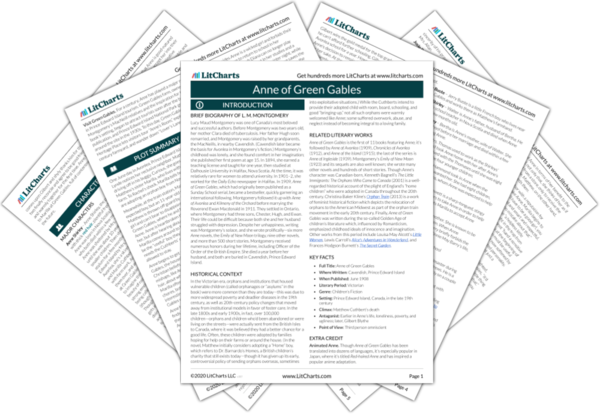Brief Biography of L. M. Montgomery
Lucy Maud Montgomery was one of Canada’s most beloved and successful authors. Before Montgomery was two years old, her mother Clara died of tuberculosis. Her father Hugh soon remarried, and Montgomery was raised by her grandparents, the MacNeills, in nearby Cavendish. (Cavendish later became the basis for Avonlea in Montgomery’s fiction.) Montgomery’s childhood was lonely, and she found comfort in her imagination; she published her first poem at age 15. In 1894, she earned a teaching license and taught for one year, then studied at Dalhousie University in Halifax, Nova Scotia. At the time, it was relatively rare for women to attend university. In 1901–2, she worked for the Daily Echo newspaper in Halifax. In 1909, Anne of Green Gables, which had originally been published as a Sunday School serial, became a bestseller, quickly garnering an international following. Montgomery followed it up with Anne of Avonlea and Kilmeny of the Orchard before marrying the Reverend Ewan Macdonald in 1911. They settled in Ontario, where Montgomery had three sons, Chester, Hugh, and Ewan. Their life could be difficult because both she and her husband struggled with depression. Despite her unhappiness, writing was Montgomery’s solace, and she wrote prolifically—six more Anne novels, the Emily of New Moon trilogy, nine other novels, and more than 500 short stories. Montgomery received numerous honors during her lifetime, including Officer of the Order of the British Empire. She died a year before her husband, and both are buried in Cavendish, Prince Edward Island.
Historical Context of Anne of Green Gables
In the Victorian era, orphans and institutions that housed vulnerable children (called orphanages or “asylums” in the book) were more common than they are today—this was due to more widespread poverty and deadlier diseases in the 19th century, as well as 20th-century policy changes that moved away from institutional models in favor of foster care. In the late 1800s and early 1900s, in fact, over 100,000 children—orphans and children who’d been abandoned or were living on the streets—were actually sent from the British Isles to Canada, where it was believed they had a better chance for a good life. Often, these children were adopted by families hoping for help on their farms or around the house. (In the novel, Matthew initially considers adopting a “Home” boy, which refers to Dr. Barnardo’s Homes, a British children’s charity that still exists today—though it has given up its early, controversial policy of sending orphans overseas, sometimes into exploitative situations.) While the Cuthberts intend to provide their adopted child with room, board, schooling, and good “bringing-up,” not all such orphans were warmly welcomed like Anne; some suffered overwork, abuse, and neglect instead of becoming integral to a loving family.
Other Books Related to Anne of Green Gables
Anne of Green Gables is the first of 11 books featuring Anne; it’s followed by
Anne of Avonlea (1909),
Chronicles of Avonlea (1912), and
Anne of the Island (1915); the last of the series is
Anne of Ingleside (1939). Montgomery’s
Emily of New Moon (1923) and its sequels are also well known; she wrote many other novels and hundreds of short stories. Though Anne’s character was Canadian-born, Kenneth Bagnell’s
The Little Immigrants: The Orphans Who Came to Canada (2001) is a well-regarded historical account of the plight of England’s “home children” who were adopted in Canada throughout the 20th century. Christina Baker Kline’s
Orphan Train (2013) is a work of feminist historical fiction which depicts the relocation of orphans to the American Midwest as part of the orphan train movement in the early 20th century. Finally,
Anne of Green Gables was written during the so-called Golden Age of children’s literature which, influenced by Romanticism, emphasized childhood ideals of innocence and imagination. Other works from this period include Louisa May Alcott’s
Little Women, Lewis Carroll’s
Alice's Adventures in Wonderland, and Frances Hodgson Burnett’s
The Secret Garden.
Key Facts about Anne of Green Gables
-
Full Title: Anne of Green Gables
-
Where Written: Cavendish, Prince Edward Island
-
When Published: June 1908
-
Literary Period: Victorian
-
Genre: Children’s Fiction
-
Setting: Prince Edward Island, Canada, in the late 19th century
-
Climax: Matthew Cuthbert’s death
-
Antagonist: Earlier in Anne’s life, loneliness, poverty, and ugliness; later, Gilbert Blythe
-
Point of View: Third person omniscient
Extra Credit for Anne of Green Gables








